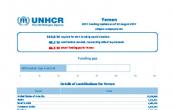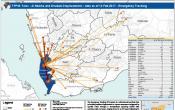Yemen
Operation: Yemen
Location
{"longitude":48,"latitude":16,"zoom_level":0}
Latest update of camps and office locations 21 Nov 2016. By clicking on the icons on the map, additional information is displayed.
Key Figures
| 2016 year-end results | |
| 67,000 | internally displaced households (444,500 individuals) received core relief items |
| 22,000 | vulnerable internally displaced households (157,000 individuals) received shelter support |
| 9,000 | vulnerable refugee households were assisted, including assistance through cash grants |
| 6,000 | new refugees and asyulum-seekers were registered |
| 4,000 | refugees and 6,000 IDP houselholds received cash assistance |
| 2017 planning figures | |
| 56,700 | targeted internally displaced households will receive core relief items |
| 50,000 | internally displaced households will receive shelter assistance and 20,000 people will receive rental subsidy |
| 31,900 | internally displaced people will be supported through cash-based interventions |
| 14,000 | refugees will receive psychological support |
| 5,000 | refugees with special needs will receive financial assistance |
Latest Updates and Related Links
People of Concern
17%
Increase in
2016
2016
| 2016 | 3,278,011 |
| 2015 | 2,809,088 |
| 2014 | 686,217 |

[["Refugees",269783],["Asylum-seekers",9097],["IDPs",2025060],["Returned IDPs",974058],["Returned refugees",1],["Others of concern",12]]
Loading ...
Yemen
< Back
2016
{"categories":[2012,2013,2014,2015,2016,2017],"budget":[72.668548722,73.02036891,55.90237687,107.42361363,124.06305842,113.6496478],"expenditure":[44.49582488,45.55776942,32.43507863,59.1504741,76.2339041,null]}
{"categories":[2012,2013,2014,2015,2016,2017],"p1":[34.512571472,34.65978173,37.76781567,54.5338847,48.97075377,63.273754],"p2":[null,null,null,null,null,null],"p3":[null,null,null,null,null,null],"p4":[38.15597725,38.36058718,18.1345612,52.88972893,75.09230465,50.3758938]}
{"categories":[2012,2013,2014,2015,2016,2017],"p1":[26.0299673,24.32612142,24.52485244,30.6292506,27.28466288,null],"p2":[null,null,null,null,null,null],"p3":[null,null,null,null,null,null],"p4":[18.46585758,21.231648,7.91022619,28.5212235,48.94924122,null]}
Loading ...
CHOOSE A YEAR
- 2014
- 2015
- 2016
- 2017
Working environment
Conditions in Yemen continued to deteriorate after two years of civil war. Some 18.8 million people needed humanitarian assistance in 2016. The already precarious humanitarian situation worsened due to substantial infrastructure damage and economic decline, further disrupting the provision of basic commodities, such as water, food, medicine and fuel, as well as services including electricity and sanitation facilities.These dire conditions have affected millions of Yemenis, including over 2 million internally displaced people (IDPs) and over 1 million people who were previously displaced and have subsequently returned back to their homes. In addition, more than 270,000 refugees, primarily from Ethiopia, Somalia and the Syrian Arab Republic, found themselves in vulnerable situations in Yemen. Furthermore, despite increasing hostilities, asylum-seekers and migrants from the Horn of Africa continued to arrive by sea. More than 117,000 new arrivals landed along the coasts of Yemen in 2016.
The uncertain political and security environment in Yemen limited the humanitarian support UNHCR could provide to populations of concern in the country.
Population trends
- The number of refugees in Yemen increased by almost 3,000 in 2016, taking the total number to about 270,000 refugees. Over the same period there were more than 9,000 asylum-seekers, a decrease of 800 since 2015.
- More than 117,000 new arrivals landed along the Yemen coasts, of which 17 per cent declared their intention to seek asylum.
- The Task Force on Population Movement, co-led by UNHCR and IOM, reported more than 2 million IDPs and 1,027,674 returnees affected by the conflict and in need of humanitarian assistance.
Achievements and impact
- UNHCR provided shelter support, including emergency shelter kits, plastic sheets and tents, to 22,423 vulnerable households.
- In addition, 48 collective centres in 10 governorates, which hosted more than 3,500 IDPs, were rehabilitate, and rental subsidies were provided to 5,970 IDP families with specific needs.
- UNHCR ensured the timely issuance of identity documentation to over 4,500 Somali refugees and helped 624 newborn refugees obtain birth certificates.
- More than 370 SGBV cases and more than 1,200 children, including unaccompanied or separated children, children at risk or children with disabilities, were assisted
- Refugees continued to have access to public health and education services
Unmet needs
As a result of underfunding and deteriorating economic/security situation, UNHCR was not able to:- Deliver basic services to the majority of collective centres and spontaneous settlements, which hosted 21 per cent of IDPs;
- Provide assistance packages to support sustainable returns for IDPs;
- Provide cash for non-food item for 20 per cent of the population in need, and;
- Provide cash for shelter for 30 per cent of the population in need;
- Carry out infrastructure rehabilitation in Kharaz refugee camp;
- Meet the chronic needs and out of camp approaches in health and education, particularly in refugee host communities.
The humanitarian situation in Yemen remains challenging. Since March 2015, armed conflict, shelling and airstrikes throughout the country have caused an unprecedented level of displacement, including among the refugee population. The gravity of the conflict prompted the activation of a system-wide Level 3 emergency response on 1 July 2015. Since the start of the conflict, over 122,000 individuals had fled Yemen to neighbouring countries by 1 September 2015.
The violence and insecurity prompted a temporary evacuation of international staff, some of whom have gradually returned to cover key positions, with appropriate security measures. The UNHCR Representative in Yemen is also the Yemen Humanitarian Coordinator. As the situation remains uncertain and insecure, UNHCR will continue to focus on delivering emergency assistance to IDPs and refugees, and on providing protection services for the entire population of concern, while collaborating with other UN agencies, non-governmental organizations and governmental entities.





